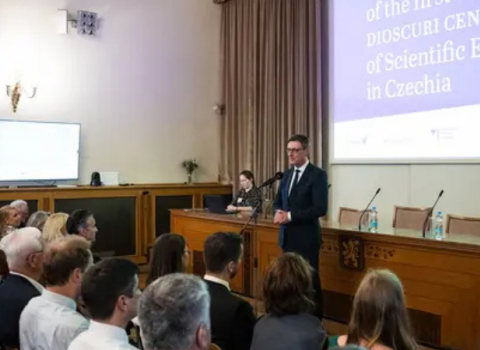The way our body reacts to compressive and tensile forces and other mechanical stress has a major impact on our health. And on medical treatments. This insight forms the basis for the unique test lab FIBEr.
The acronym of the recently recognised ‘KU Leuven Core Facility’ says it all: the dozens of types of tissues that make up our bodies, from muscles to nerves and blood vessels to bones, are all made of fibres. Body tissues naturally also contain different types of cells, but it’s mostly the fibres that determine their mechanical properties.
These properties play an important role in our health because all tissues in our body are under constant mechanical stress: just think of the impact on your bones and the tension in your muscles and tendons during exercise, or the continuous strain on your heart valve with every heartbeat. The FIBEr lab studies the effect of such mechanical stresses on healthy, diseased or repaired body tissue.
“We quantify the mechanical properties of both body tissues and prostheses and implants,” says Professor Nele Famaey, coordinator of FIBEr. “This data can be used to see to what extent a prosthesis succeeds in mimicking the body's own tissue. We can also use it to assess the effects of a specific treatment.” The data can also serve as input for in silico experiments, computer simulations that calculate the effects of, for example, mechanical stresses on the body. “These simulations complement clinical studies, possibly reducing the amount of animal testing."
One-of-a-kind reference centre
The lab on the Arenberg Campus has the technology and expertise to study a wide range of tissue types. To this end, FIBEr has state-of-the-art testing equipment: hyper-precise devices that map out the mechanical properties (e.g. by means of tensile or compression tests, and this along several axes and on both a macro and micro scale), but also cutting-edge imaging techniques such as a micro CT scanner. “We can run tests on a single cell, but also on complete body parts and medical implants,” says Famaey.
“Of course, we’re not the only lab in the world performing biomechanical tests, but the variety of test equipment grouped in one facility is one of a kind,” says Famaey. Another asset is the broad range of expertise at FIBEr: while Famaey focuses on research into soft tissues, her colleagues and co-founders Lennart Scheys and Harry van Lenthe are responsible for the biomechanics of joints and ligaments and of the skeleton, respectively. Moreover, Famaey and her colleagues master the entire workflow of biomechanical research. “In addition to the actual experiments, we can help with the proper acquisition of samples, as well as the preservation and preparation of these samples. And after the experiments, we help to correctly process and, if required, interpret the measurement data."
"Of course, we’re not the only lab in the world performing biomechanical tests, but the variety of test equipment grouped in one facility is one of a kind.", says Famaey.
To offer this comprehensive service, FIBEr has an entire team, including a full-time lab manager, two project engineers, a research expert and a business developer. Although the test lab was only established in 2017, FIBEr is already regarded as a global reference centre for the quantification of biomechanical properties. And in this, too, it is unique, because the relatively new field is still somewhat lacking a real gold standard. The variation in test methods between laboratories is too great for that. To study this arbitrariness, FIBEr recently sent tissue samples to 25 other labs around the world as part of a European campaign. “We want to gain more insight into the current variability in biomechanical testing. Together with the partners, we then want to achieve a generally accepted and, thus, better test method." The fact that the lab has now been recognised as a Core Facility only adds to its image as a reference centre and also creates important additional opportunities for continued growth and innovation, especially when it comes to the test methods in the FIBEr portfolio.
Biocompatibility is key
A random selection from the collection of projects carried out over the past four years highlights the strong interdisciplinary nature of the research. In the lab, for example, the researchers examined the mechanical differences between a healthy and a poorly functioning heart valve. For surgical meshes, they looked at the optimal properties for the repair of abdominal wall fractures. And for orthopaedics, they studied the stability of a new hip prosthesis and determined how well the current knee prostheses succeed in reproducing the normal movement of and stress on a knee joint. Famaey: "Biocompatibility is central to our research: as with organ transplants, we want to achieve the best possible match between a body tissue on the one hand and the operation or prosthesis on the other hand.”
The lab is open to national and international academic researchers as well as the industry. Within KU Leuven, there is of course a strong collaboration with University Hospitals Leuven. That is why FIBEr hopes to open a satellite lab in Gasthuisberg before the end of the year. Companies can ‘hire’ the lab as a type of subcontractor. "We carry out the tests and provide the customers with the results,” says Famaey. In recent years, FIBEr has already worked with several companies, for example on the development of artificial blood vessels and surgical sutures.
The recognition as a Core Facility is valid for five years and can be renewed. The funding runs for three years.
Collaborate with FIBEr
Do you want to perform your research at FIBEr? Or do you want to use their services to characterise the mechanical properties of your medical device or tissue?
This article was first published on 23 February by KU Leuven.





 A unique international forum for public research organisations and companies to connect their external engagement with strategic interests around their R&D system.
A unique international forum for public research organisations and companies to connect their external engagement with strategic interests around their R&D system.